Yamaha F80A, F100A, F100B User Manual
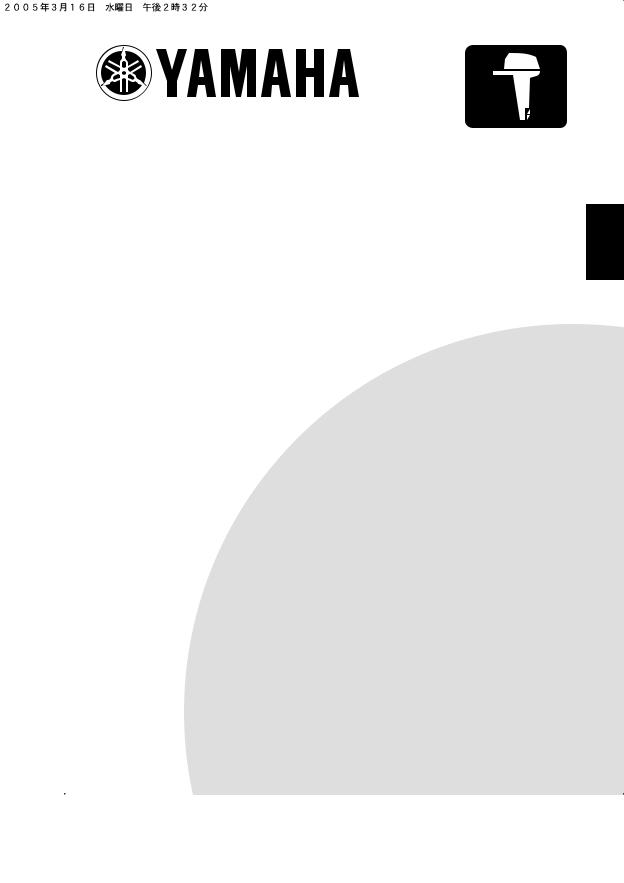
F80A
F100A
F100B
OWNER’S MANUAL
67F-28199-79-E0
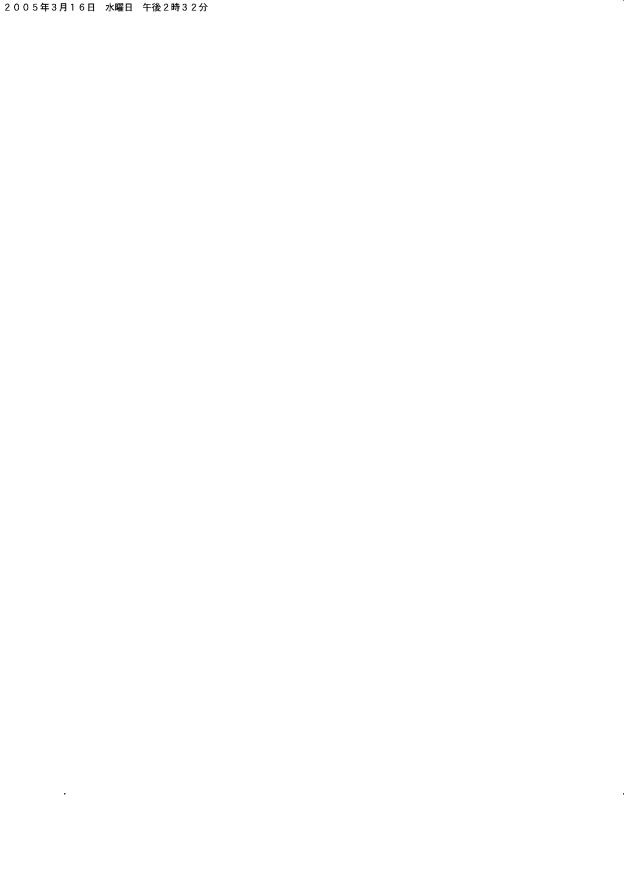
EMU25050
Read this owner’s manual carefully before operating your outboard motor.
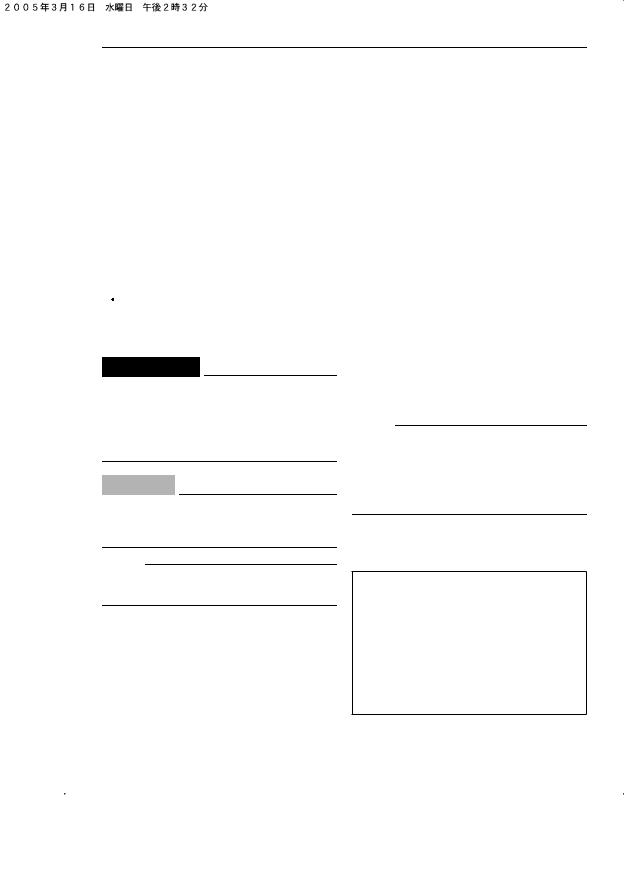
Important manual information
EMU25101
To the owner
Thank you for choosing a Yamaha outboard motor. This Owner’s Manual contains information needed for proper operation, maintenance and care. A thorough understanding of these simple instructions will help you obtain maximum enjoyment from your new Yamaha. If you have any question about the operation or maintenance of your outboard motor, please consult a Yamaha dealer.
In this Owner’s Manual particularly important information is distinguished in the following ways.
 The Safety Alert Symbol means ATTENTION! BECOME ALERT! YOUR SAFETY IS INVOLVED!
The Safety Alert Symbol means ATTENTION! BECOME ALERT! YOUR SAFETY IS INVOLVED!
EWM00780
 WARNING
WARNING
Failure to follow WARNING instructions could result in severe injury or death to the machine operator, a bystander, or a person inspecting or repairing the outboard motor.
ECM00700
CAUTION:
A CAUTION indicates special precautions that must be taken to avoid damage to the outboard motor.
NOTE:
A NOTE provides key information to make procedures easier or clearer.
Yamaha continually seeks advancements in product design and quality. Therefore, while this manual contains the most current product information available at the time of printing, there may be minor discrepancies between your machine and this manual. If there is any question concerning this manu-
al, please consult your Yamaha dealer.
To ensure long product life, Yamaha recommends that you use the product and perform the specified periodic inspections and maintenance by correctly following the instructions in the owner’s manual. Note that if you do not follow these instructions, not only may the product break down, but the warranty will also be voided.
Some countries have laws or regulations restricting users from taking the product out of the country where it was purchased, and it may be impossible to register the product in the destination country. Additionally, the warranty may not apply in certain regions. When planning to take the product to another country, consult the dealer where the product was purchased for further information.
If the product was purchased used, please consult your closest dealer for customer reregistration, and to be eligible for the specified services.
NOTE:
The F80AET, F100AET, F100BET and the standard accessories are used as a base for the explanations and illustrations in this manual. Therefore some items may not apply to every model.
EMU25120
F80A, F100A, F100B
OWNER’S MANUAL ©2005 by Yamaha Motor Co., Ltd.
1st Edition, April 2005 All rights reserved.
Any reprinting or unauthorized use without the written permission of Yamaha Motor Co., Ltd.
is expressly prohibited. Printed in Japan
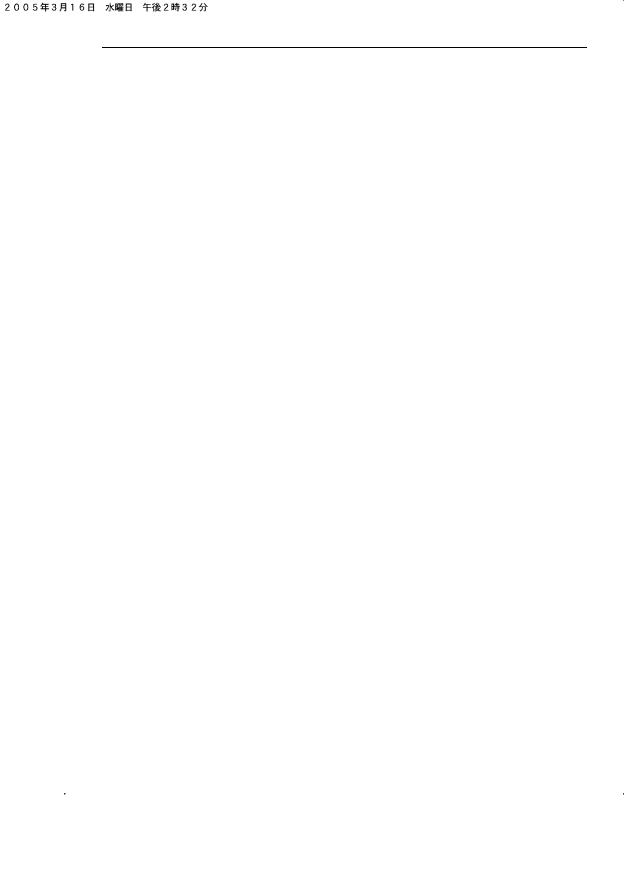
Table of contents
General information .......................... |
1 |
Identification numbers record.......... |
1 |
Outboard motor serial number .......... |
1 |
Key number....................................... |
1 |
EC label........................................... |
1 |
Emission control information ........... |
2 |
SAV models ...................................... |
2 |
Safety information ........................... |
3 |
Important labels............................... |
4 |
Warning labels .................................. |
4 |
Fueling instructions ......................... |
4 |
Gasoline ............................................ |
5 |
Engine oil .......................................... |
5 |
Battery requirement......................... |
5 |
Battery specifications ........................ |
6 |
Propeller selection........................... |
6 |
Start-in-gear protection ................... |
7 |
Basic components ............................ |
8 |
Main components............................ |
8 |
Fuel tank ........................................... |
9 |
Fuel joint ......................................... |
10 |
Fuel gauge ...................................... |
10 |
Fuel tank cap .................................. |
10 |
Air vent screw ................................. |
10 |
Remote control................................ |
10 |
Remote control lever ....................... |
10 |
Neutral interlock trigger ................... |
11 |
Neutral throttle lever........................ |
11 |
Tiller handle .................................... |
11 |
Gear shift lever................................ |
11 |
Throttle grip ..................................... |
12 |
Throttle indicator ............................. |
12 |
Throttle friction adjuster................... |
12 |
Engine stop lanyard switch ............. |
13 |
Engine stop button .......................... |
13 |
Main switch ..................................... |
14 |
Steering friction adjuster ................. |
14 |
Power trim and tilt switch on |
|
remote control or tiller handle ....... |
14 |
Power trim and tilt switch on |
|
bottom engine cowling .................. |
15 |
Trim tab with anode ........................ |
15 |
Tilt support lever for power trim |
|
and tilt or hydro tilt model.............. |
16 |
Top cowling lock lever |
|
(pull up type) ................................. |
16 |
Flushing device ............................... |
17 |
Warning indicator ............................ |
17 |
Digital tachometer ........................... |
17 |
Low oil pressure warning |
|
indicator ........................................ |
18 |
Overheat warning indicator |
|
(digital type) .................................. |
18 |
Speedometer (digital type) .............. |
18 |
Trim meter (digital type) .................. |
19 |
Hour meter ...................................... |
19 |
Hour meter (digital type).................. |
19 |
Trip meter........................................ |
20 |
Clock ............................................... |
20 |
Fuel gauge ...................................... |
21 |
Fuel warning indicator ..................... |
21 |
Low battery voltage warning |
|
indicator ........................................ |
21 |
Warning system ............................ |
22 |
Overheat warning............................ |
22 |
Low oil pressure warning ................ |
22 |
Operation ......................................... |
24 |
Installation..................................... |
24 |
Mounting the outboard motor .......... |
24 |
Breaking in engine ........................ |
25 |
Procedure for 4-stroke models........ |
25 |
Preoperation checks ..................... |
25 |
Fuel ................................................. |
25 |
Controls........................................... |
26 |
Engine ............................................. |
26 |
Checking the engine oil level .......... |
26 |
Filling fuel...................................... |
26 |
Operating engine .......................... |
27 |
Feeding fuel (portable tank) ............ |
27 |
Starting engine ................................ |
28 |
Warming up engine....................... |
30 |
Manual start and electric start |
|
models .......................................... |
30 |
Shifting .......................................... |
31 |
Forward (tiller handle and |
|
remote control models) ................. |
31 |
Reverse (automatic reverse lock |
|
and power trim and tilt models)..... |
32 |
Stopping engine............................ |
32 |
Procedure........................................ |
32 |
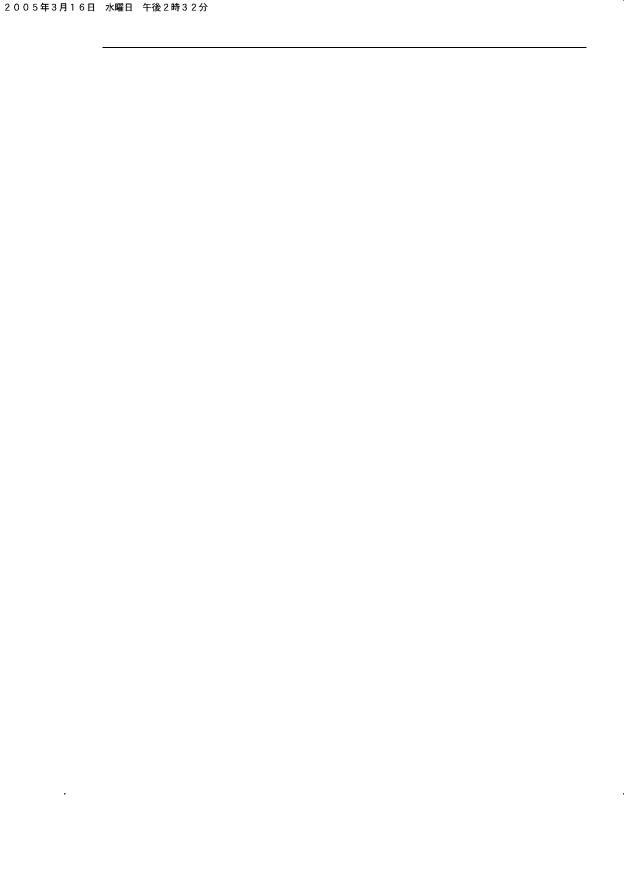
Table of contents
Trimming outboard motor.............. |
33 |
Adjusting trim angle ........................ |
33 |
Adjusting boat trim .......................... |
34 |
Tilting up and down ....................... |
35 |
Procedure for tilting up .................... |
36 |
Procedure for tilting down ............... |
37 |
Cruising in shallow water .............. |
38 |
Power trim and tilt models / |
|
power tilt models........................... |
38 |
Cruising in other conditions........... |
39 |
Maintenance..................................... |
40 |
Specifications ................................ |
40 |
Transporting and storing |
|
outboard motor............................ |
41 |
Storing outboard motor ................... |
42 |
Procedure ....................................... |
42 |
Lubrication (except oil injection |
|
models) ......................................... |
43 |
Battery care..................................... |
43 |
Flushing power unit ......................... |
44 |
Cleaning the outboard motor .......... |
45 |
Checking painted surface of |
|
motor............................................. |
45 |
Periodic maintenance.................... |
45 |
Replacement parts .......................... |
45 |
Maintenance chart .......................... |
46 |
Maintenance chart (additional)........ |
47 |
Greasing ......................................... |
48 |
Cleaning and adjusting |
|
spark plug ..................................... |
49 |
Checking fuel system ...................... |
50 |
Inspecting fuel filter ......................... |
51 |
Cleaning fuel filter ........................... |
51 |
Inspecting idling speed ................... |
52 |
Changing engine oil ........................ |
52 |
Checking wiring and connectors ..... |
54 |
Exhaust leakage ............................. |
54 |
Water leakage ................................. |
54 |
Engine oil leakage........................... |
54 |
Checking power trim and tilt |
|
system .......................................... |
54 |
Checking power trim and tilt / |
|
power tilt system ........................... |
55 |
Checking propeller .......................... |
56 |
Removing the propeller ................... |
57 |
Installing the Propeller..................... |
57 |
Changing gear oil ............................ |
58 |
Cleaning fuel tank ........................... |
59 |
Inspecting and replacing |
|
anode(s)........................................ |
59 |
Checking battery (for electric |
|
start models) ................................. |
60 |
Connecting the battery .................... |
61 |
Disconnecting the battery................ |
62 |
Checking top cowling ...................... |
62 |
Coating the boat bottom.................. |
62 |
Trouble Recovery............................ |
63 |
Troubleshooting ............................ |
63 |
Temporary action in emergency ... |
66 |
Impact damage ............................... |
66 |
Replacing fuse ................................ |
66 |
Power trim and tilt / power tilt |
|
will not operate.............................. |
67 |
Starter will not operate .................... |
67 |
Emergency starting engine ............. |
68 |
Engine fails to operate .................. |
69 |
Ignition system malfunction............. |
69 |
Treatment of submerged motor .... |
70 |
Procedure........................................ |
70 |
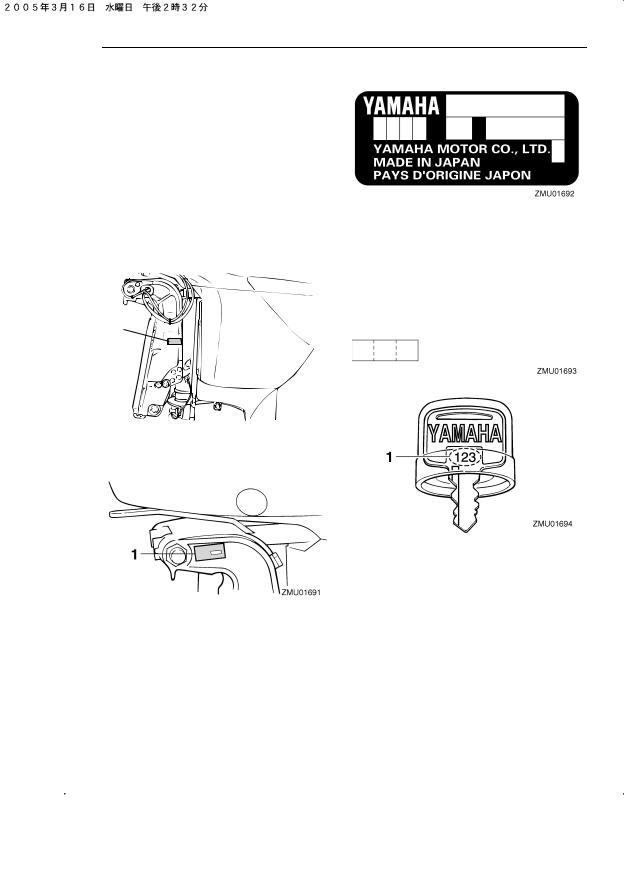
General information
EMU25170
Identification numbers record
EMU25182
Outboard motor serial number
The outboard motor serial number is stamped on the label attached to the port side of the clamp bracket or the upper part of the swivel bracket.
Record your outboard motor serial number in the spaces provided to assist you in ordering spare parts from your Yamaha dealer or for reference in case your outboard motor is stolen.
1 |
ZMU04214 |
1. Outboard motor serial number location
EMU25190
Key number
If a main key switch is equipped with the motor, the key identification number is stamped on your key as shown in the illustration. Record this number in the space provided for reference in case you need a new key.
1. Key number
EMU25202
EC label
Engines affixed with this label conform to 1. Outboard motor serial number location certain portions of the European Parliament directive relating to machinery. Refer to the label and the EC Declaration of Conformity
for more details.
1

General information
Approval label of emission control certificate
1
1 |
ZMU04215 |
1. EC label location |
ZMU05067 |
|
1. Approval label location |
ZMU01696
EMU25221
Emission control information
EMU25351
SAV models
Engines affixed with the label pictured below conform to SAV (the Swiss exhaust emission regulations for Swiss inshore waters).
YAMAHA MOTOR CO.,LTD.
Motorfamilie
Abgastypenpruf-
Nummer
ZMU04492
Fuel requirement label
1
ZMU05068
1. Fuel requirement label location
2
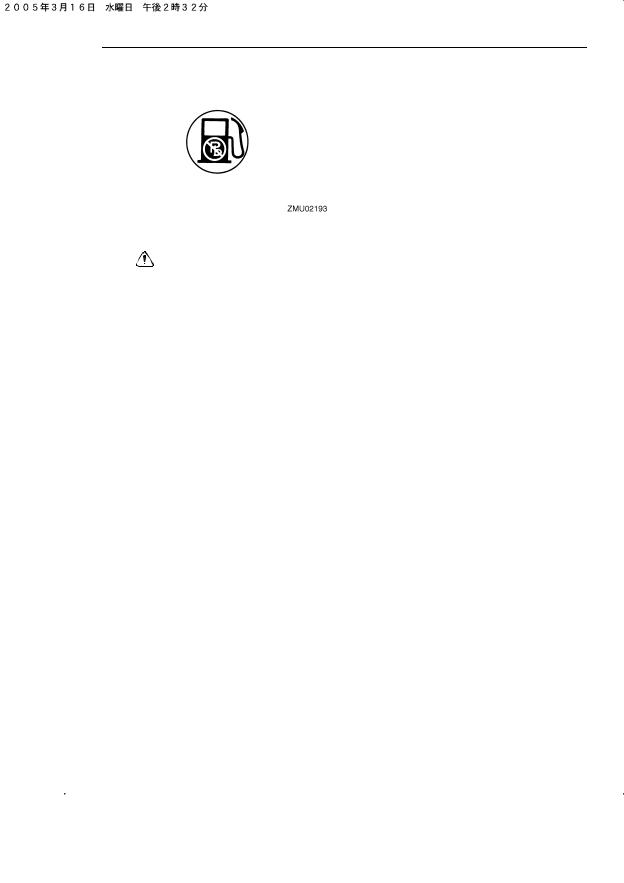
General information
EMU25371
Safety information
●Before mounting or operating the outboard motor, read this entire manual. Reading it should give you an understanding of the motor and its operation.
●Before operating the boat, read any owner’s or operator’s manuals supplied with it and all labels. Be sure you understand each item before operating.
●Do not overpower the boat with this outboard motor. Overpowering the boat could result in loss of control. The rated power of the outboard should be equal to or less than the rated horsepower capacity of the boat. If the rated horsepower capacity of the boat is unknown, consult the dealer or boat manufacturer.
●Do not modify the outboard. Modifications could make the motor unfit or unsafe to use.
●Incorrect propeller selection and incorrect use may not only cause engine damage, but also adversely affect fuel consumption. Consult your dealer for correct use.
●Never operate after drinking alcohol or taking drugs. About 50% of all boating fatalities involve intoxication.
●Have an approved personal flotation device (PFD) on board for every occupant. It
is a good idea to wear a PFD whenever boating. At a minimum, children and nonswimmers should always wear PFDs, and everyone should wear PFDs when there are potentially hazardous boating conditions.
●Gasoline is highly flammable, and its vapors are flammable and explosive. Handle and store gasoline carefully. Make sure there are no gas fumes or leaking fuel before starting the engine.
●This product emits exhaust gases which contain carbon monoxide, a colorless, odorless gas which may cause brain damage or death when inhaled. Symptoms include nausea, dizziness, and drowsiness. Keep cockpit and cabin areas well ventilated. Avoid blocking exhaust outlets.
●Check throttle, shift, and steering for proper operation before starting the engine.
●Attach the engine stop switch lanyard to a secure place on your clothing, or your arm or leg while operating. If you accidentally leave the helm, the lanyard will pull from the switch, stopping the engine.
●Know the marine laws and regulations where you will be boating - and obey them.
●Stay informed about the weather. Check weather forecasts before boating. Avoid boating in hazardous weather.
●Tell someone where you are going: leave a Float Plan with a responsible person. Be sure to cancel the Float Plan when you return.
●Use common sense and good judgment when boating. Know your abilities, and be sure you understand how your boat handles under the different boating conditions you may encounter. Operate within your limits, and the limits of your boat. Always operate at safe speeds, and keep a careful
3
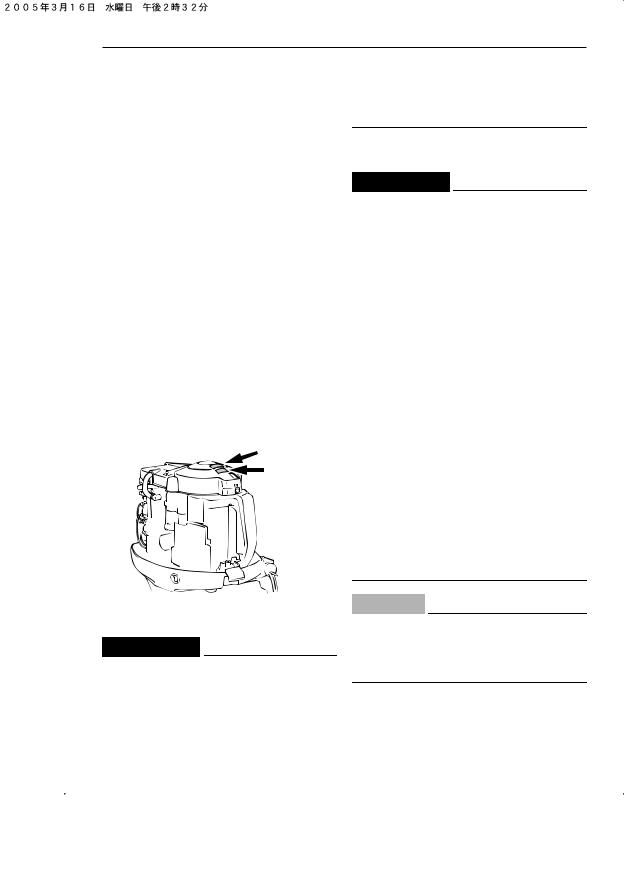
General information
watch for obstacles and other traffic.
●Always watch carefully for swimmers during the engine operation.
●Stay away from swimming areas.
●When a swimmer is in the water near you shift into neutral and shut off the engine.
●Do not illegally discard empty containers used to replace or replenish oil. For the correct processing of empty containers, consult the dealer where you purchased the oil.
●When replacing oils used to lubricate the product (engine or gear oil), be sure to wipe away any spilt oil. Never pour oil without using a funnel or similar device. If necessary, verify the necessary replacement procedure with the dealer.
●Never illegally discard (dump) the product. Yamaha recommends consulting the deal-
er on discarding the product.
EMU25382
Important labels
EMU25395
Warning labels
ZMU05054
EMU25401
Label
EWM01260
 WARNING
WARNING
●Be sure shift control is in neutral before starting engine. (except 2HP)
●Do not touch or remove electrical parts
when starting or during operation.
●Keep hands, hair, and clothes away from flywheel and other rotating parts while engine is running.
EMU25540
Fueling instructions
EWM00010
 WARNING
WARNING
GASOLINE AND ITS VAPORS ARE HIGHLY FLAMMABLE AND EXPLOSIVE!
●Do not smoke when refueling, and keep away from sparks, flames, or other sources of ignition.
●Stop engine before refueling.
●Refuel in a well-ventilated area. Refuel portable fuel tanks off the boat.
●Take care not to spill gasoline. If gasoline spills, wipe it up immediately with dry rags.
●Do not overfill the fuel tank.
●Tighten the filler cap securely after refueling.
●If you should swallow some gasoline, inhale a lot of gasoline vapor, or get gasoline in your eyes, get immediate medical attention.
●If any gasoline spills onto your skin, immediately wash with soap and water. Change clothing if gasoline spills on it.
●Touch the fuel nozzle to the filler opening or funnel to help prevent electrostatic sparks.
ECM00010
CAUTION:
Use only new clean gasoline which has been stored in clean containers and is not contaminated with water or foreign matter.
4
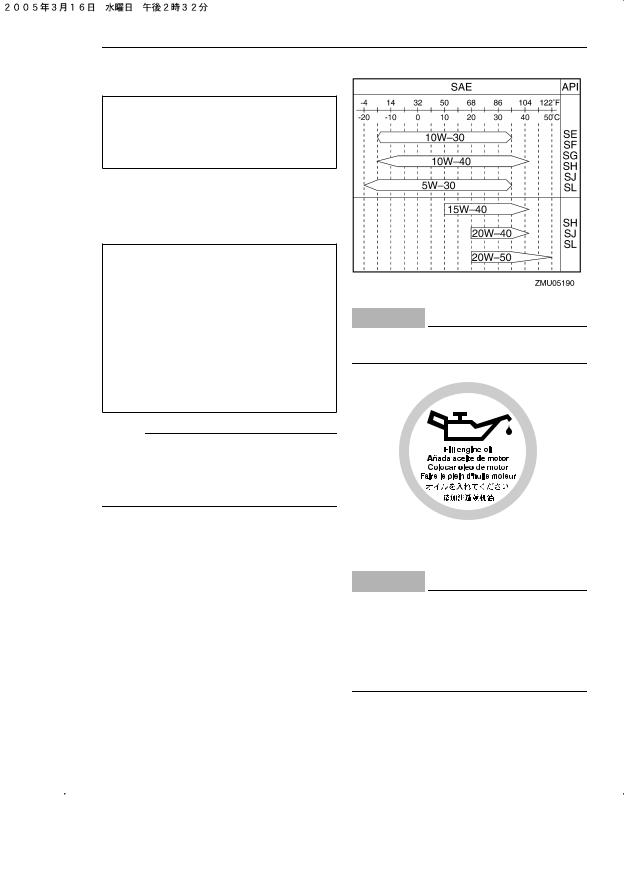
General information
EMU25580
Gasoline
Recommended gasoline:
Regular unleaded gasoline with a minimum octane rating of 90 (Research Octane Number).
If knocking or pinging occurs, use a different brand of gasoline or premium unleaded fuel.
EMU25683
Engine oil
Recommended engine oil:
4-stroke motor oil with a combination of the following SAE and API oil classifications
Engine oil type SAE: 10W-30 or 10W-40 Engine oil grade API:
SE, SF, SG, SH, SJ, SL
Engine oil quantity (excluding oil filter): 4.3 L (4.55 US qt) (3.78 Imp.qt)
NOTE:
If the recommended engine oil grades are not available, select an alternative from the following chart according to the average temperatures in your area.
ECM01050
CAUTION:
All 4-stroke engines are shipped from the factory without engine oil.
ZMU01710
EMU25690
Battery requirement
ECM01060
CAUTION:
Do not use a battery that does not meet the specified capacity. If a battery which does not meet specifications is used, the electric system could perform poorly or be overloaded, causing electric system damage.
For electric start models, choose a battery
5
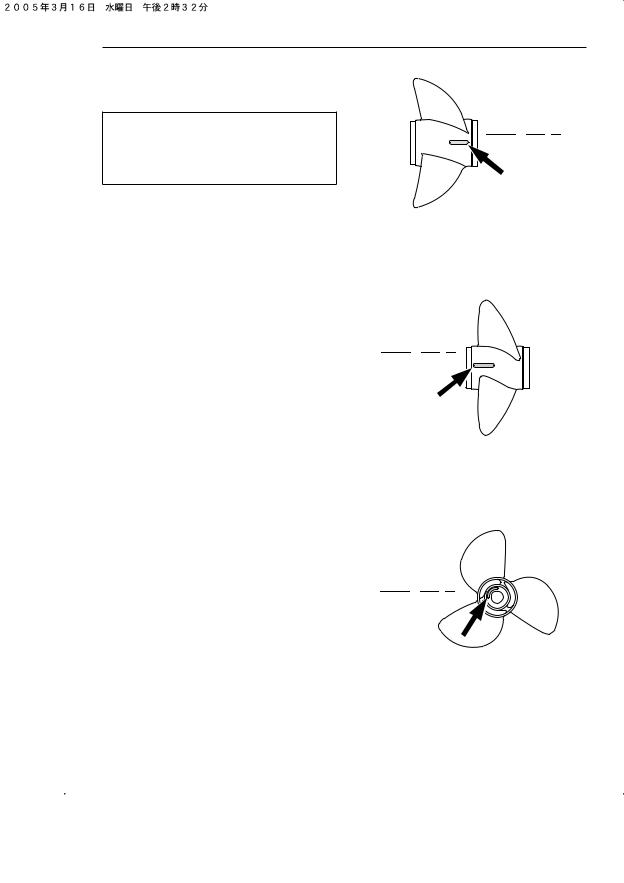
General information
which meets the following specifications.
EMU25720
Battery specifications
Minimum cold cranking amps (CCA/EN): 430.0 A
Minimum rated capacity (20HR/IEC): 70.0 Ah
EMU25742
Propeller selection
The performance of your outboard motor will be critically affected by your choice of propeller, as an incorrect choice could adversely affect performance and could also seriously damage the motor. Engine speed depends on the propeller size and boat load. If engine speed is too high or too low for good engine performance, this will have an adverse effect on the engine.
Yamaha outboard motors are fitted with propellers chosen to perform well over a range of applications, but there may be uses where a propeller with a different pitch would be more appropriate. For a greater operating load, a smaller-pitch propeller is more suitable as it enables the correct engine speed to be maintained. Conversely, a larger-pitch propeller is more suitable for a smaller operating load.
Yamaha dealers stock a range of propellers, and can advise you and install a propeller on your outboard that is best suited to your application.

 x
x -
-
 1 2 3
1 2 3
ZMU04605
1.Propeller diameter in inches
2.Propeller pitch in inches
3.Type of propeller (propeller mark)

 x
x -
-
 1 2 3
1 2 3
ZMU04606
1.Propeller diameter in inches
2.Propeller pitch in inches
3.Type of propeller (propeller mark)

 x
x -
-
 1 2 3
1 2 3
ZMU04607
1.Propeller diameter in inches
2.Propeller pitch in inches
3.Type of propeller (propeller mark)
6
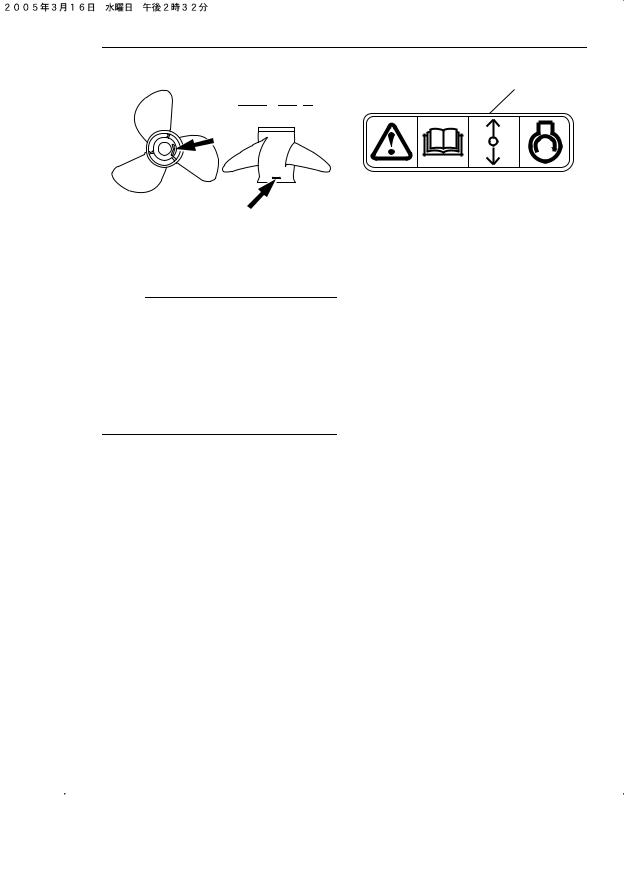
General information
1

 x
x -
-
 1 2 3
1 2 3
ZMU04608 |
ZMU01713 |
1. Propeller diameter in inches |
1. Start-in-gear protection label |
2. Propeller pitch in inches |
|
3. Type of propeller (propeller mark) |
|
NOTE:
Select a propeller which will allow the engine to reach the middle or upper half of the operating range at full throttle with the maximum boat load. If operating conditions such as light boat loads then allow the engine r/min to rise above the maximum recommended range, reduce the throttle setting to maintain the engine in the proper operating range.
For instructions on propeller removal and installation, see page 56.
EMU25760
Start-in-gear protection
Yamaha outboard motors affixed with the pictured label or Yamaha-approved remote control units are equipped with start-in-gear protection device(s). This feature permits the engine to be started only when it is in neutral. Always select neutral before starting the engine.
7
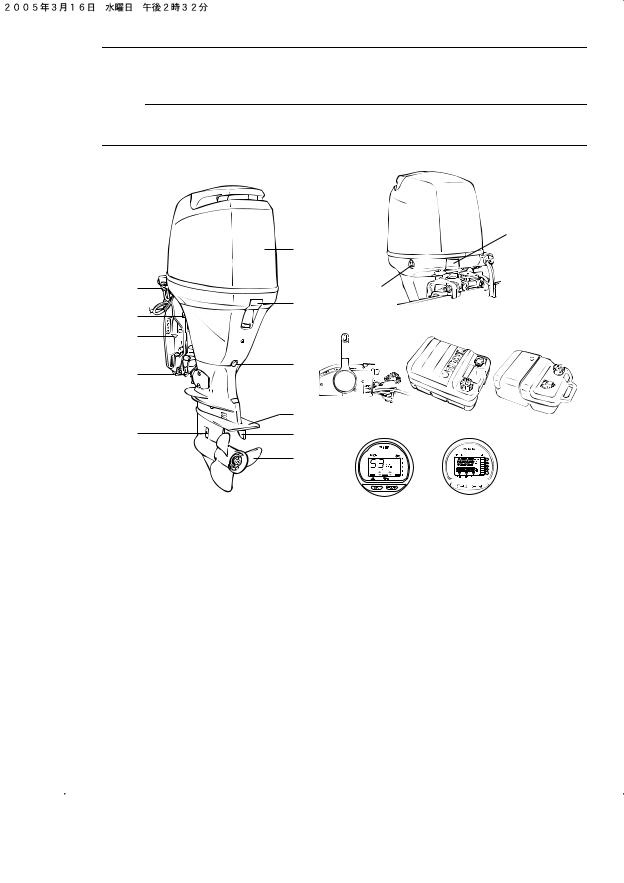
Basic components
EMU25796
Main components
NOTE:
* May not be exactly as shown; also may not be included as standard equipment on all models.
F80A, F100A
|
|
|
2 |
|
1 |
|
|
11 |
2 |
|
12 |
|
|
||
10 |
|
|
|
|
|
|
|
9 |
13 |
|
14 |
8 |
3 |
|
|
|
|
|
|
|
4 |
|
|
7 |
5 |
15 |
16 |
|
6 |
|
|
|
|
|
ZMU05070 |
1. Top cowling |
|
15. Digital tachometer |
|
2. Top cowling lock lever |
|
16. Digital speedometer |
|
3.Drain screw
4.Anti-cavitation plate
5.Trim tab (anode)
6.Propeller
7.Cooling water inlet
8.Anode
9.Clamp bracket
10.Tilt support lever
11.Flushing device
12.Power trim and tilt switch
13.Remote control box (side mount type)*
14.Fuel tank*
8
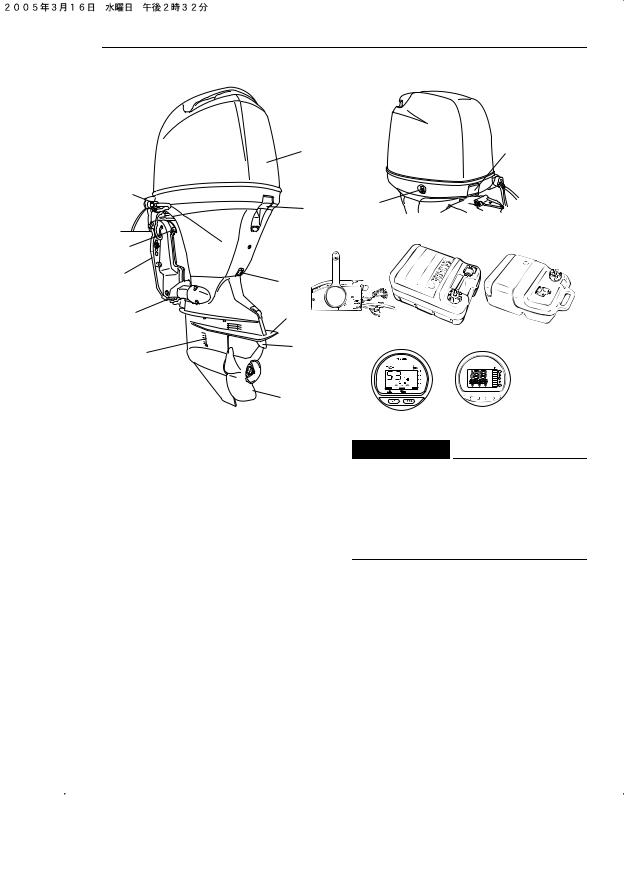
Basic components
F100B
|
1 |
11 |
|
|
2 |
10 |
13 |
|
|
9 |
3 |
|
|
8 |
4 |

 5 7
5 7 
6
1.Top cowling
2.Top cowling lock lever
3.Drain screw
4.Anti-cavitation plate
5.Trim tab (anode)
6.Propeller
7.Cooling water inlet
8.Anode
9.Clamp bracket
10.Tilt support lever
11.Flushing device
12.Power trim and tilt switch
13.Remote control box (side mount type)*
14.Fuel tank*
15.Digital tachometer*
16.Digital speedometer*
EMU25802
Fuel tank
If your model was equipped with a portable
2
12
14
15 16
YAMAHA
SPEED
Km/h knot mph
km mile
TRIP TIME BATT
set mode
ZMU05071
fuel tank, its function is as follows.
EWM00020
 WARNING
WARNING
The fuel tank supplied with this engine is its dedicated fuel reservoir and must not be used as a fuel storage container. Commercial users should conform to relevant licensing or approval authority regulations.
9
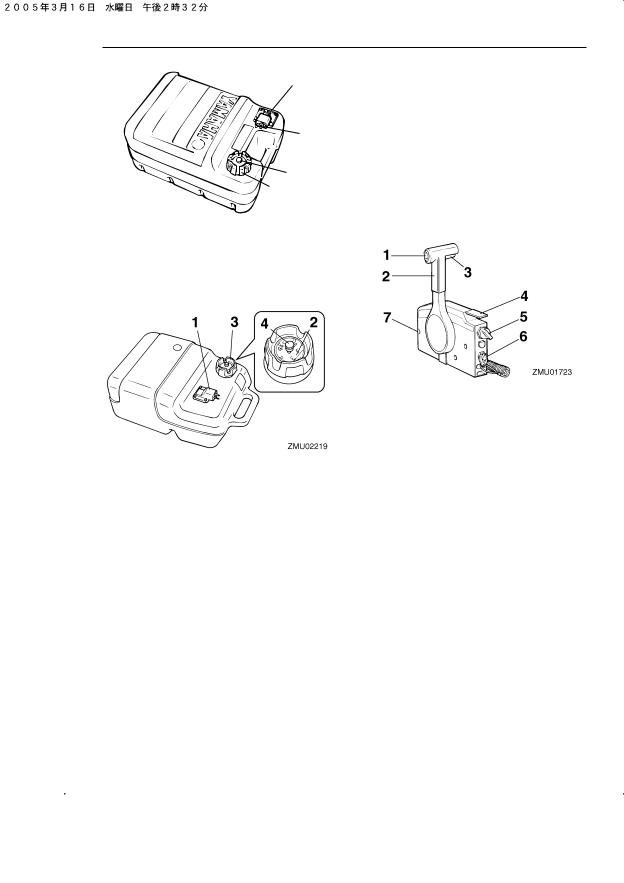
Basic components
2
1
4
3
ZMU02284
1.Fuel joint
2.Fuel gauge
3.Fuel tank cap
4.Air vent screw
1.Fuel joint
2.Fuel gauge
3.Fuel tank cap
4.Air vent screw
EMU25830
Fuel joint
This joint is used to connect the fuel line.
EMU25841
Fuel gauge
This gauge is located on either the fuel tank cap or on the fuel joint base. It shows the approximate amount of fuel remaining in the tank.
EMU25850
Fuel tank cap
This cap seals the fuel tank. When removed,
the tank can be filled with fuel. To remove the cap, turn it counterclockwise.
EMU25860
Air vent screw
This screw is on the fuel tank cap. To loosen the screw, turn it counterclockwise.
EMU26180
Remote control
The remote control lever actuates both the shifter and the throttle. The electrical switches are mounted on the remote control box.
1.Power trim and tilt switch
2.Remote control lever
3.Neutral interlock trigger
4.Neutral throttle lever
5.Main switch / choke switch
6.Engine stop lanyard switch
7.Throttle friction adjuster
EMU26190
Remote control lever
Moving the lever forward from the neutral position engages forward gear. Pulling the lever back from neutral engages reverse. The engine will continue to run at idle until the lever is moved about 35° (a detent can be felt). Moving the lever farther opens the throttle, and the engine will begin to accelerate.
10
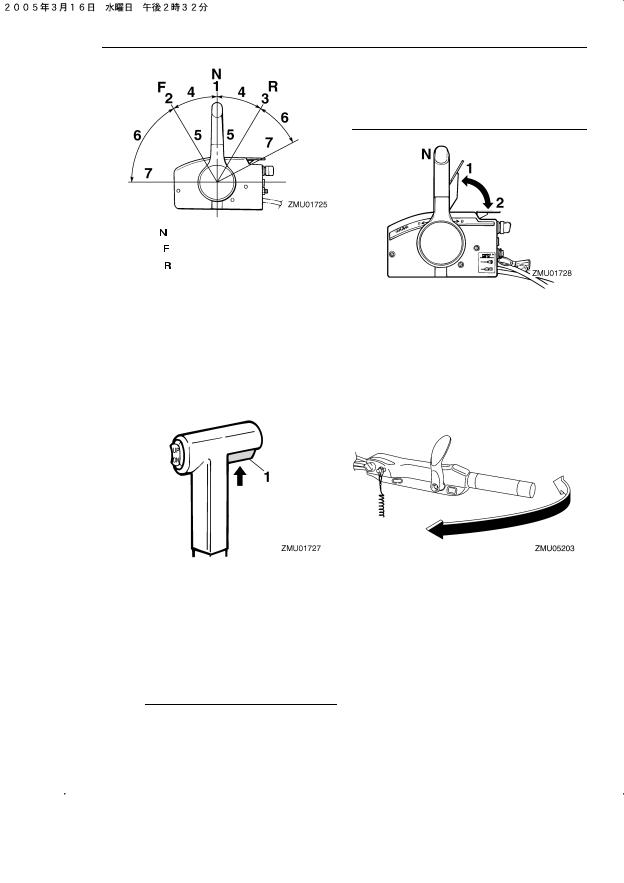
Basic components
1.Neutral “ ”
2.Forward “ ”
3.Reverse “ ”
4.Shift
5.Fully closed
6.Throttle
7.Fully open
EMU26201
Neutral interlock trigger
To shift out of neutral, first pull the neutral interlock trigger up.
1. Neutral interlock trigger
EMU26211
Neutral throttle lever
To open the throttle without shifting into either forward or reverse, put the remote control lever in the neutral position and lift the neutral throttle lever.
NOTE:
The neutral throttle lever will operate only
when the remote control lever is in neutral. The remote control lever will operate only when the neutral throttle lever is in the closed position.
1.Fully open
2.Fully closed
EMU25911
Tiller handle
To change direction, move the tiller handle to the left or right as necessary.
EMU25922
Gear shift lever
Pulling the gear shift lever towards you puts the engine in forward gear so that the boat moves ahead. Pushing the lever away from you puts the engine in reverse gear so that the boat moves astern.
11
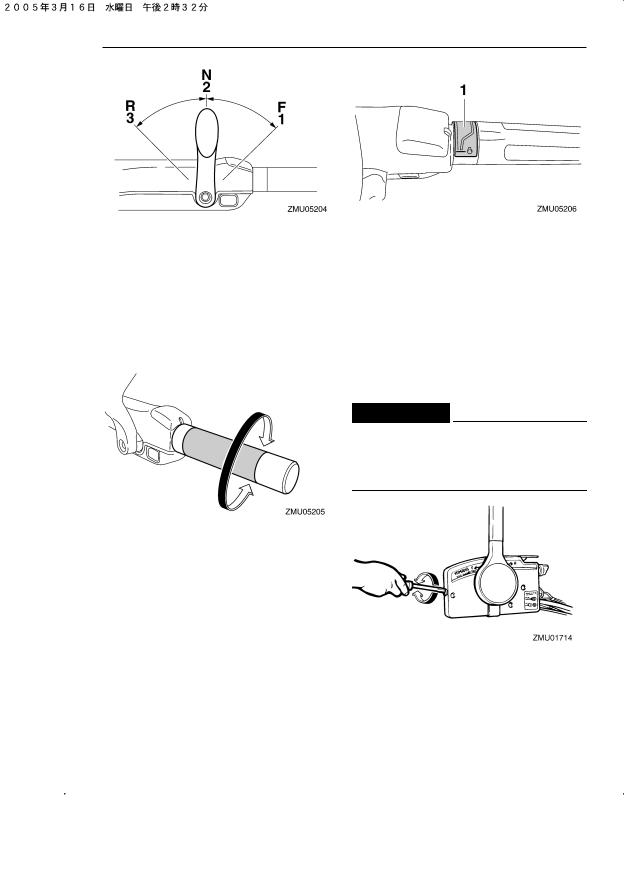
Basic components
1.Forward “ ”
”
2.Neutral “ ”
”
3.Reverse “ ”
”
EMU25941
Throttle grip
The throttle grip is on the tiller handle. Turn the grip counterclockwise to increase speed and clockwise to decrease speed.
1. Throttle indicator
EMU25970
Throttle friction adjuster
A friction device provides adjustable resistance to movement of the throttle grip or the remote control lever, and can be set according to operator preference.
To increase resistance, turn the adjuster clockwise. To decrease resistance, turn the adjuster counterclockwise.
EWM00030
 WARNING
WARNING
Do not overtighten the friction adjuster. If there is too much resistance, it could be difficult to move throttle lever or grip, which could result in an accident.
EMU25961
Throttle indicator
The fuel consumption curve on the throttle indicator shows the relative amount of fuel consumed for each throttle position. Choose the setting that offers the best performance and fuel economy for the desired operation.
12
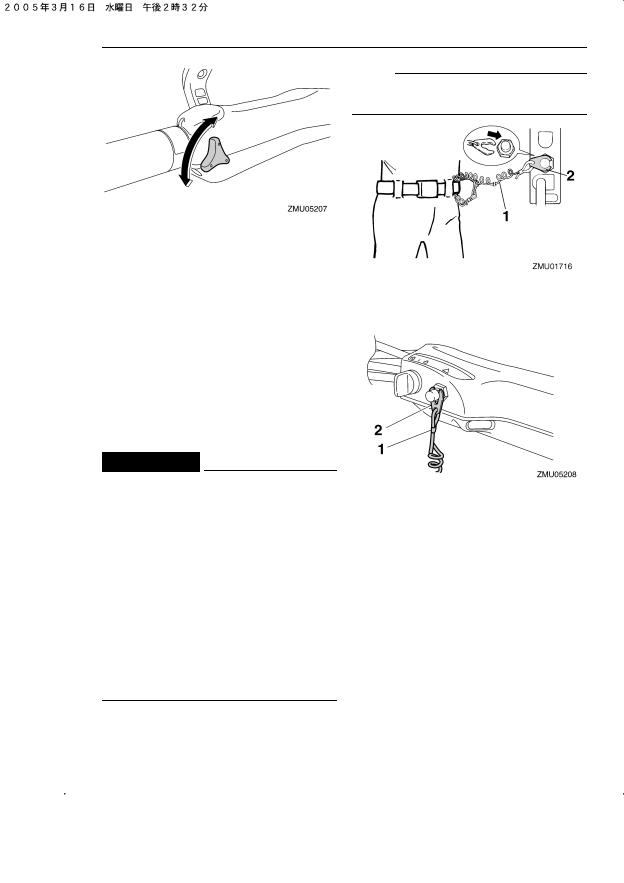
Basic components
When constant speed is desired, tighten the adjuster to maintain the desired throttle setting.
EMU25990
Engine stop lanyard switch
The lock plate must be attached to the engine stop switch for the engine to run. The lanyard should be attached to a secure place on the operator’s clothing, or arm or leg. Should the operator fall overboard or leave the helm, the lanyard will pull out the lock plate, stopping ignition to the engine. This will prevent the boat from running away under power.
EWM00120
 WARNING
WARNING
●Attach the engine stop switch lanyard to a secure place on your clothing, or your arm or leg while operating.
●Do not attach the lanyard to clothing that could tear loose. Do not route the lanyard where it could become entangled, preventing it from functioning.
●Avoid accidentally pulling the lanyard during normal operation. Loss of engine power means the loss of most steering control. Also, without engine power, the boat could slow rapidly. This could cause people and objects in the boat to be thrown forward.
NOTE:
The engine cannot be started with the lock plate removed.
1.Lanyard
2.Lock plate
1.Lanyard
2.Lock plate
EMU26001
Engine stop button
To open the ignition circuit and stop the engine, push this button.
13
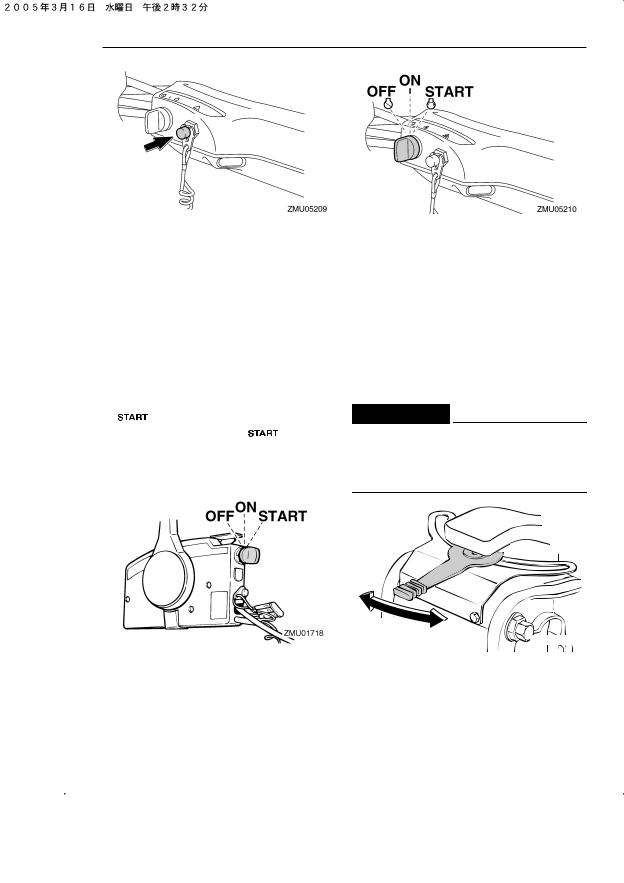
Basic components
EMU26090
Main switch
The main switch controls the ignition system; its operation is described below.
● “
 ” (off)
” (off)
With the main switch in the “
 ” (off) position, the electrical circuits are off, and the key can be removed.
” (off) position, the electrical circuits are off, and the key can be removed.
● “ ” (on)
” (on)
With the main switch in the “ ” (on) position, the electrical circuits are on, and the key cannot be removed.
” (on) position, the electrical circuits are on, and the key cannot be removed.
● “ |
” (start) |
|
With the main switch in the “ |
” (start) po- |
|
sition, the starter motor turns to start the engine. When the key is released, it returns automatically to the “ ” (on) position.
” (on) position.
EMU26110
Steering friction adjuster
A friction device provides adjustable resistance to the steering mechanism, and can be set according to operator preference. An adjuster lever is located on the bottom of the tiller handle bracket.
To increase resistance, turn the lever to the left.
To decrease resistance, turn the lever to the right.
EWM00040
 WARNING
WARNING
Do not overtighten the friction adjuster. If there is too much resistance, it could be difficult to steer, which could result in an accident.
ZMU02810
EMU26141
Power trim and tilt switch on remote control or tiller handle
The power trim and tilt system adjusts the
14
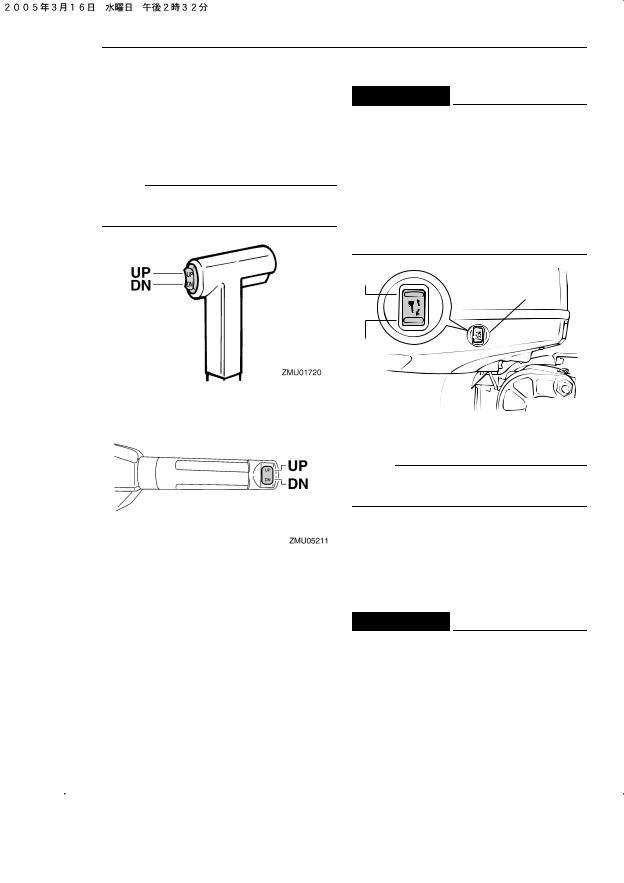
Basic components
outboard motor angle in relation to the transom. Pressing the switch “ ” (up) trims the outboard motor up, then tilts it up. Pressing the switch “
” (up) trims the outboard motor up, then tilts it up. Pressing the switch “ ” (down) tilts the outboard motor down and trims it down. When the switch is released, the outboard motor will stop in its current position.
” (down) tilts the outboard motor down and trims it down. When the switch is released, the outboard motor will stop in its current position.
NOTE:
For instructions on using the power trim and tilt switch, see pages 33 and 35.
current position.
EWM01030
 WARNING
WARNING
Use the power trim and tilt switch located on the bottom engine cowling only when the boat is at a complete stop with the engine off. Attempting to use this switch while the boat is moving could increase the risk of falling overboard and could distract the operator, increasing the risk of collision with another boat or an obstacle.
UP
1
DN
EMU26151
Power trim and tilt switch on bottom engine cowling
The power trim and tilt switch is located on the side of the bottom engine cowling. Pressing the switch “ ” (up) trims the outboard motor up, then tilts it up. Pressing the switch “
” (up) trims the outboard motor up, then tilts it up. Pressing the switch “ ” (down) tilts the outboard motor down and trims it down. When the switch is released, the outboard motor will stop in its
” (down) tilts the outboard motor down and trims it down. When the switch is released, the outboard motor will stop in its
ZMU04223
1. Power trim and tilt switch
NOTE:
For instructions on using the power trim and tilt switch, see page 35.
EMU26241
Trim tab with anode
The trim tab should be adjusted so that the steering control can be turned to either the right or left by applying the same amount of force.
EWM00840
 WARNING
WARNING
An improperly adjusted trim tab could cause difficult steering. Always test run after the trim tab has been installed or replaced to be sure steering is correct. Be sure you have tightened the bolt after ad-
15
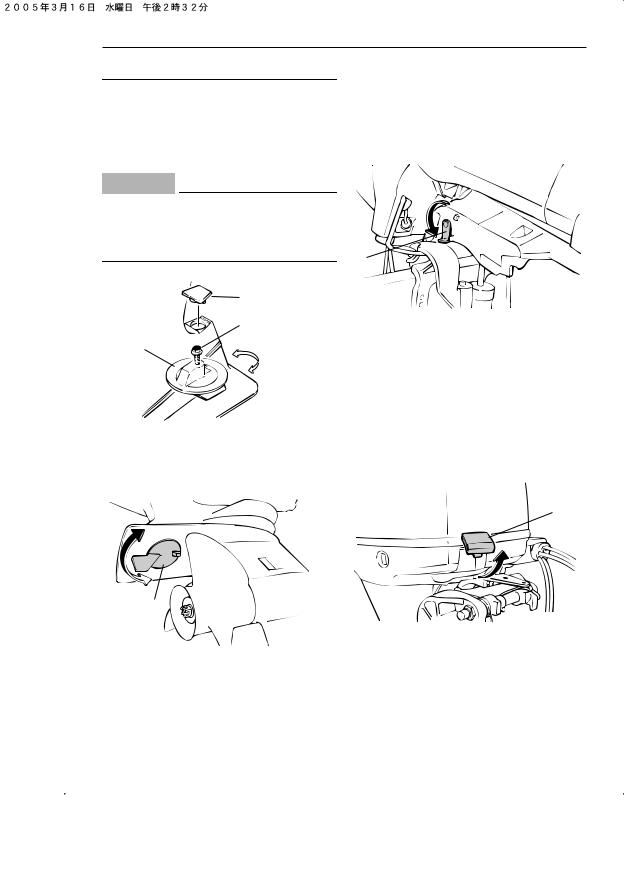
Basic components
justing the trim tab.
If the boat tends to veer the left (port side), turn the trim tab rear end to the port side “A” in the figure. If the boat tends to veer the right (starboard side), turn the trim tab end to the starboard side “B” in the figure.
ECM00840
CAUTION:
The trim tab also serves as an anode to protect the engine from electrochemical corrosion. Never paint the trim tab as it will become ineffective as an anode.
3
2
1  B
B
 A
A
ZMU02525
1.Trim tab
2.Bolt
3.Cap
EMU26340
Tilt support lever for power trim and tilt or hydro tilt model
To keep the outboard motor in the tilted up position, lock the tilt support lever to the clamp bracket.
1 |
ZMU04224 |
1. Tilt support lever
EMU26382
Top cowling lock lever (pull up type)
To remove the engine top cowling, pull up the lock lever(s) and lift off the cowling. When installing the cowling, check to be sure it fits properly in the rubber seal. Then lock the cowling by moving the lever(s) downward.
1
B
A
1
ZMU04225
ZMU05048
1. Top cowling lock lever(s)
1. Trim tab
16
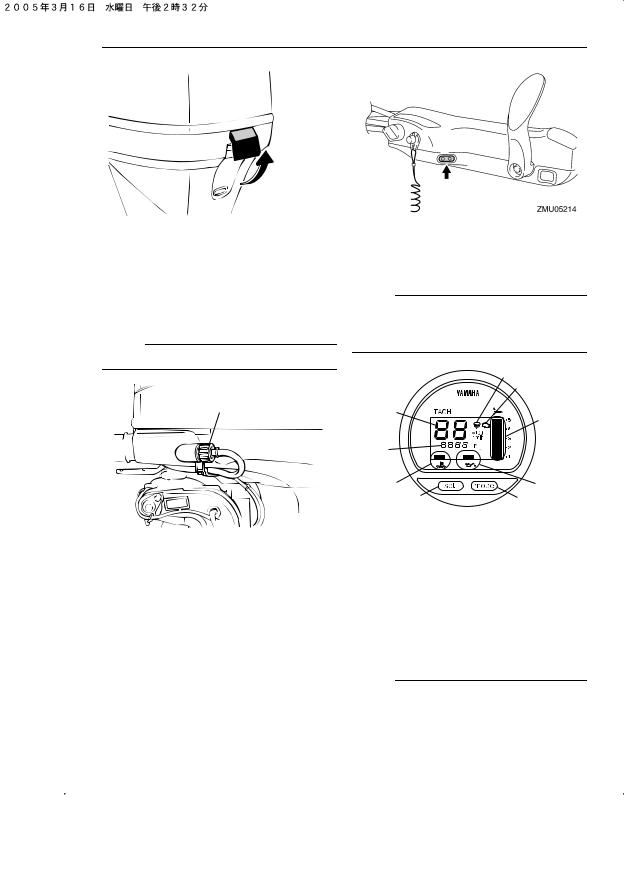
Basic components

 1
1
ZMU04226
1. Top cowling lock lever(s)
EMU26460
Flushing device
This device is used to clean the cooling water passages of the motor using a garden hose and tap water.
NOTE:
For details on usage, see page 44.
1
ZMU04256
1. Flushing device
EMU26301
Warning indicator
If the engine develops a condition which is cause for warning, the indicator lights up. For details on how to read the warning indicator, see page 22.
EMU26491
Digital tachometer
The tachometer shows the engine speed and has the following functions.
NOTE:
All segments of the display will light momentarily after the main switch is turned on and will return to normal thereafter.
|
6 |
|
7 |
1 |
2 |
|
3 |
5 |
|
4 |
8 |
9 |
ZMU04185 |
1.Tachometer
2.Trim meter
3.Hour meter
4.Low oil pressure warning indicator
5.Overheat warning indicator
6.Water separator warning indicator
7.Engine trouble warning indicator
8.Set button
9.Mode button
NOTE:
The water separator and engine trouble warning indicators only operate when the en-
17
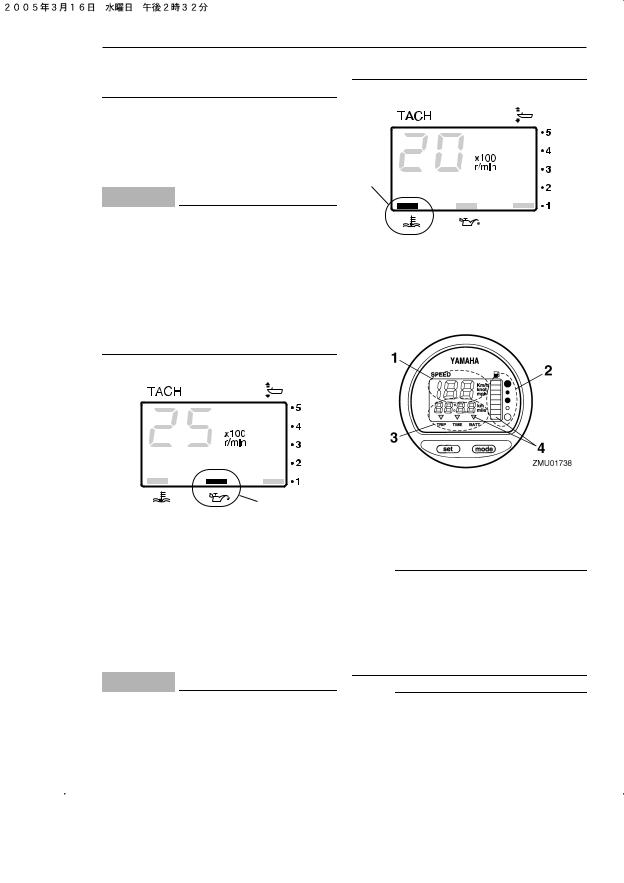
Basic components
gine is equipped with the appropriate functions.
EMU26521
Low oil pressure warning indicator
If oil pressure drops too low, the warning indicator will start to blink. For further information, see page 22.
ECM00020
CAUTION:
●Do not continue to run the engine if the low oil pressure warning indicator is on and the engine oil level is lower. Serious engine damage will occur.
●The low oil pressure warning indicator does not indicate the engine oil level. Use the oil dipstick to check the remaining oil quantity. For further information, see page 26.
engine damage will occur.
1
ZMU01737
1. Overheat warning indicator
EMU26600
Speedometer (digital type)
This gauge shows the boat speed.
1 ZMU01736
1. Low oil pressure warning indicator
EMU26581
Overheat warning indicator (digital type)
If the engine temperature rises too high, the warning indicator will start to blink. For further information on reading the indicator, see page 22.
ECM00050
CAUTION:
Do not continue to run the engine if the overheat warning indicator is on. Serious
1.Speedometer
2.Fuel gauge
3.Trip meter/clock/voltmeter
4.Warning indicator(s)
NOTE:
After the main switch is first turned on, all segments of the display come on as a test. After a few seconds, the gauge will change to normal operation. Watch the gauge when turning on the main switch to make sure all segments come on.
NOTE:
The speedometer displays km/h, mph, or
18
